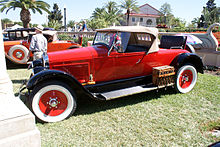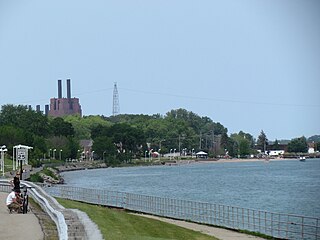
Marysville is a city in St. Clair County of the U.S. state of Michigan. The population was 9,959 at the 2010 census. The municipality was founded in 1919, first as a village, then became a city in 1924.

Kaiser Motors Corporation made automobiles at Willow Run, Michigan, United States, from 1945 until 1953. In 1953, Kaiser merged with Willys-Overland to form Willys Motors Incorporated, moving its production operations to the Willys plant at Toledo, Ohio, where the company continued to build automobiles under the Kaiser marque including the Kaiser Darrin until 1955. Their South American operations continued to build passenger cars well up into the 1960s. The company changed its name to Kaiser Jeep Corporation in 1963.
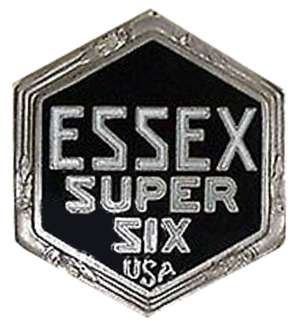
The Essex was a brand of automobile produced by the Essex Motor Company between 1918 and 1922, and by Hudson Motor Car Company of Detroit, Michigan between 1922 and 1933.

Checker Motors Corporation was an vehicle manufacturer, and later an automotive subcontractor, based in Kalamazoo, Michigan. The company was established by Morris Markin in 1922, created by a merger of the firms Commonwealth Motors and Markin Automobile Body, and was initially named the Checker Cab Manufacturing Company. The manufacturer was originally based in Chicago, before moving to Kalamazoo in 1923. The company was renamed Checker Motors in 1958.

The Ford Piquette Avenue Plant is a former factory located within the Milwaukee Junction area of Detroit, Michigan, in the United States. Built in 1904, it was the second center of automobile production for the Ford Motor Company, after the Ford Mack Avenue Plant. At the Piquette Avenue Plant, the company created and first produced the Ford Model T, the car credited with initiating the mass use of automobiles in the United States. Prior to the Model T, several other car models were assembled at the factory. Early experiments using a moving assembly line to make cars were also conducted there. It was also the first factory where more than 100 cars were assembled in one day. While it was headquartered at the Piquette Avenue Plant, Ford Motor Company became the biggest U.S.-based automaker, and it would remain so until the mid-1920s. The factory was used by the company until 1910, when its car production activity was relocated to the new, larger Highland Park Ford Plant.

The Dort Motor Car Company of Flint, Michigan, built automobiles from 1915 to 1924.

Automotive design is the process of developing the appearance of motor vehicles, including automobiles, motorcycles, trucks, buses, coaches, and vans.
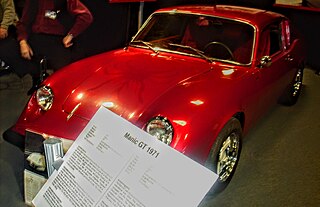
The Manic GT is a sports car that was built in the province of Québec in Canada from 1969 to 1971. Production of the car was first based in Terrebonne and was later moved to Granby.
Changan Automobile Co., Ltd.(CCAG) is a Chinese state-owned automobile manufacturer headquartered in Jiangbei, Chongqing. Changan Automobile traces its origins back to 1862 when Li Hongzhang set up a military supply factory, the Shanghai Foreign Gun Bureau. It was not until 1979 when the factory was repurposed to manufacture Suzuki automobiles that it became an automobile manufacturer. It is currently the smallest of the "Big Four" state-owned car manufacturers of China, namely: SAIC Motor, FAW Group, Dongfeng Motor Corporation, and Changan Automobile, with car sales of 5.37 million, 3.50 million, 3.28 million and 2.30 million in 2021 respectively.
The automotive industry in the Soviet Union spanned the history of the state from 1929 to 1991. It started with the establishment of large car manufacturing plants and reorganisation of the AMO Factory in Moscow in the late 1920s–early 1930s, during the first five-year plan, and continued until the Soviet Union's dissolution in 1991.

William Bushnell Stout was a pioneering American inventor, engineer, developer and designer whose works in the automotive and aviation fields were groundbreaking. Known by the nickname "Bill", Stout designed an aircraft that eventually became the Ford Trimotor and was an executive at the Ford Motor Company.

Frederick Samuel Duesenberg was a German-born American automobile and engine designer, manufacturer and sportsman who was internationally known as a designer of racecars and racing engines. Duesenberg's engineering expertise influenced the development of the automobile, especially during the 1910s and 1920s. He is credited with introducing an eight-cylinder engine, also known as the Duesenberg Straight-8 engine, and four-wheel hydraulic brakes, a first for American cars, in addition to other mechanical innovations. Duesenberg was also patentholder of his designs for a four-wheel hydraulic brake, an early automatic transmission, and a cooling system, among others. Fred and his younger brother, August "Augie" Duesenberg, shared the patents, filed in 1913 and renewed in 1918, for their "walking beam" four-cylinder engine and the Duesenberg Straight 8.

Since 2009, the United States is home to the second largest passenger vehicle market of any country in the world, second to China. Overall, there were an estimated 263.6 million registered vehicles in the United States in 2015, most of which were passenger vehicles. This number, along with the average age of vehicles, has increased steadily since 1960. The United States is also home to three large vehicle manufacturers: General Motors, Ford Motor Company, and Chrysler, which have historically been referred to as the "Big Three".
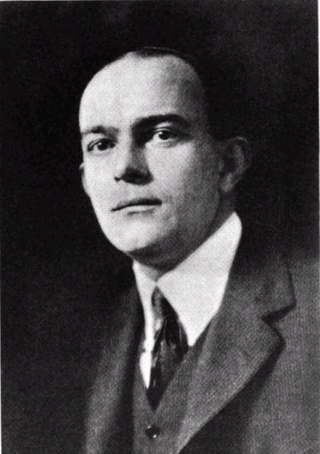
Childe Harold Wills was an American engineer and businessman. He was an early associate of Henry Ford, one of the first employees of the Ford Motor Company, and the chief contributor to the design of the Model T. After leaving Ford, he began his own automobile company.
While there are no saints named St. Claire in English, there are several saints named St. Clare. They are spelled "Ste. Claire" in French.
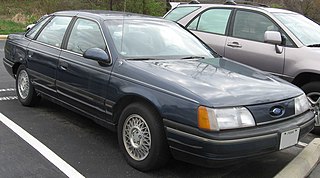
The first-generation Ford Taurus and Mercury Sable are automobiles produced by Ford as the first of six generations of the Ford Taurus and Mercury Sable. Launched on December 26, 1985, as a 1986 model, the front-wheel-drive Taurus was a very influential design that is credited with saving Ford from bankruptcy, bringing many innovations to the marketplace and starting the trend towards aerodynamic design for the American automakers in the North American market. Ford of Europe had launched the 1980s move to aerodynamic design for the company with the 1982 Ford Sierra.

In the United States, the automotive industry began in the 1890s and, as a result of the size of the domestic market and the use of mass production, rapidly evolved into the largest in the world. The United States was the first country in the world to have a mass market for vehicle production and sales and is a pioneer of the automotive industry and mass market production process. During the 20th century, global competitors emerged, especially in the second half of the century primarily across European and Asian markets, such as Germany, France, Italy, Japan and South Korea. The U.S. is currently second among the largest manufacturers in the world by volume.

Willys was a brand name used by Willys–Overland Motors, an American automobile company, founded by John North Willys. It was best known for its design and production of World War II–era military jeeps (MBs), Willys M38 and M38A1 military jeeps as well as civilian versions, and branding the 'jeep' military slang-word into the '(Universal) Jeep' marque.
Port Huron & Detroit Railroad Company was incorporated on September 1, 1917, in the State of Michigan, United States of America, to own and operate 14 miles (23 km) of railroad track along the Saint Clair River from Port Huron, Michigan, to Marine City, Michigan. It remained in business until it was sold to the Chesapeake and Ohio Railway in December 1984. Most of its original trackage is still being operated today by CSX Transportation Co. with whom Chesapeake and Ohio Railway merged into on September 2, 1987.
